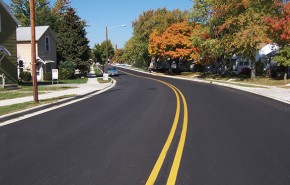Historically coal-producing regions of the United States are dotted with abandoned mine land (AML) sites that present a range of hazards including stream contamination, fall hazards, the dangers of landslides, subsidence, and more. While site remediation requirements were implemented with the Surface Mining Control and Reclamation Act of 1977, entities charged with compliance have historically lacked access to sufficient funding for substantial AML remediation initiatives.
With $11.3B of federal funding for abandoned mine land (AML) work being made available over 15 years through the Bipartisan Infrastructure Law (BIL), organizations in coal-producing areas of the U.S. now have access to increased funds for the implementation of significantly more AML projects and establishment of related ongoing maintenance programs.
For more than 40 years, GAI has provided clients with a comprehensive range of AML services in historically coal-producing U.S. regions like Pennsylvania, West Virginia, and Ohio. Informed by extensive experience, GAI approaches challenging AML initiatives with a deep understanding of the complex impacts that abandoned mine structures and mine drainage issues can have on the environment. GAI leverages this knowledge and background to deploy the collaborative skills of hundreds of multidiscipline professionals to offer AML services that address geotechnical considerations like landslides, impoundment stability, mine subsidence, and high-wall hazards, perform archaeological impact studies, provide support for permitting and regulatory compliance, and address a range of environmental considerations such as stream remediation and restoration, studies and recommendations for soil amendments to restore plant life, watershed assessment, active and passive water-treatment facility design, and more.
Q: Please introduce yourself and talk about the role you play in providing AML services at GAI.
![]() I’m Charlie Straley, PE, PLS and I have been providing AML and mine land reclamation services to various clients for more than 30 years. My role is as a technical advisor providing review and technical insight into a range of abandoned mine land project techniques.
I’m Charlie Straley, PE, PLS and I have been providing AML and mine land reclamation services to various clients for more than 30 years. My role is as a technical advisor providing review and technical insight into a range of abandoned mine land project techniques.
![]() My name is Arica DiTullio, PE, MS. I manage an engineering division here at GAI, and for AML projects I serve as a project manager and technical lead in wastewater and environmental engineering support. My background working on AML projects also includes looking to remediate mine lands utilizing coal ash as a beneficial use material.
My name is Arica DiTullio, PE, MS. I manage an engineering division here at GAI, and for AML projects I serve as a project manager and technical lead in wastewater and environmental engineering support. My background working on AML projects also includes looking to remediate mine lands utilizing coal ash as a beneficial use material.
![]() I am John Klamut, PE, CFM, MS and with GAI I oversee our AML projects and assign projects in order to present clients with GAI staff who specialize in various aspects of AML services. The tasks required to successfully complete a given AML initiative can vary greatly depending on the project, so we draw from a wide variety of engineering disciplines for such work.
I am John Klamut, PE, CFM, MS and with GAI I oversee our AML projects and assign projects in order to present clients with GAI staff who specialize in various aspects of AML services. The tasks required to successfully complete a given AML initiative can vary greatly depending on the project, so we draw from a wide variety of engineering disciplines for such work.
![]() My name is Jason Gandee, and I have worked on numerous AML projects for the state of West Virginia. Currently, I’m acting as project manager for a range of AML projects, and in addition to keeping jobs on track internally I regularly interact with AML clients to help make sure that we successfully deliver the solutions they want and need.
My name is Jason Gandee, and I have worked on numerous AML projects for the state of West Virginia. Currently, I’m acting as project manager for a range of AML projects, and in addition to keeping jobs on track internally I regularly interact with AML clients to help make sure that we successfully deliver the solutions they want and need.
Today, four key contributors to GAI’s AML practice offer some background on AML and illustrate a path forward for clients seeking to take advantage of a unique opportunity to move ahead with a range of initiatives aimed to help benefit the environment, comply with government requirements, and improve safety for area residents.
Q: To start off, can any of you offer a brief description of AML work?
Charlie: AML is the clean-up and remediation of abandoned coal mine sites, which became required as part of the Surface Mining Control and Reclamation Act of 1977. At that point, coal companies had to start bonding and providing reclamation plans to qualify for their mining permits. The federal government also established a fund to provide money for AML work, which was financed by fees collected from current coal operators in a given area and administered by the Office of Surface Mining Reclamation and Enforcement (OSMRE).
Jason: Left un-remediated, abandoned mines present hazards like acid mine drainage, open mine portals, high walls that that could potentially lead to the injury of area residents, and more.
Arica: We perform AML work for a variety of clients including the Bureau of Abandoned Mine Reclamation in Pennsylvania and the Office of Abandoned Mine Lands & Reclamation in West Virginia, as well as nonprofit or watershed groups that are looking to conduct clean-up efforts. We are starting to see more conservation districts and other entities looking to drive these projects, which I credit to the recent passage of the BIL and its opportunity for expanded funding for this type of work.
Q: Can you touch upon how the BIL helps advance AML initiatives?
Charlie: There have been AML funding issues over the entirety of the high coal production period here in the U.S. Indeed, AML was largely paused for a while when the authorization for collecting fees from coal providers to fund AML work expired for a period prior to the passage of BIL. But even before the pause those who needed this work were receiving only minimal funding and performing what work they could in-house. But through BIL’s seeding of the OSMRE program, they are getting access to more money than they have staff, and we see many coming to consultants like us for the services they need. The BIL’s spending formula gives a number of states a significant amount of money, and many are formulating how to spend the funds now as they may not be available in the future.
Jason: The AML funds provided by the infrastructure bill are available to pay for work performed over the next 15 years—it’s a use it or lose it opportunity, and one of the challenges for clients is defining and initiating projects to use the money that they have available.
Arica: I do know that within Pennsylvania there are many projects that have been in need, so it’s a big push to catch up and execute many projects now that there is a funding mechanism in place.
John: What’s really advantageous is the fact that the new AML funding comes directly from the U.S. Treasury, which minimizes funding delay that could be associated with a tax-driven funding source.
Another thing that’s come out of the BIL is that the additional funding is allowing counties to apply for grants for qualifying agencies, nonprofits, and other entities to pick up some of the workload for managing some AML issues in their own jurisdictions.
Arica: It’s also exciting that BIL funding has given more of a mechanism to support projects that previously were not seen as immediate hazards—so it will make available more funding for systems to address concerns like acid mine drainage and water-quality improvement. Also, grant recipients are permitted to put aside funding for future years just for upkeep and maintenance for these systems, which was a deterrent to addressing some of these sites in the past.
![]()
Q: Can you talk about the range of AML services that GAI provides?
Charlie: GAI can provide AML services from the beginning to the end of AML projects, including the National Environmental Policy Act (NEPA) and other environmental studies and the resulting work, archaeology and cultural resources studies, right-of-entry and right-of-way negotiations with property owners, and straight on through to AML project design, construction management and monitoring, and providing professional opinion that the work performed has met the regulatory requirements necessary to certify the project’s successful completion. We also provide a portfolio of restoration services for streams that have been damaged by mining activities to help them provide a better environment for a range of aquatic life.
John: GAI has a long history of providing AML engineering design and permitting services for entities including the State Departments in West Virginia, Ohio, and Pennsylvania.
The typical AML project will draw from a wide sampling of the skills that GAI provides, including site investigations, environmental assessment, permitting for stream and wetlands and other site work, potentially a drilling or test-pit investigation to assess the geotechnical properties of specific sites, evaluation of slope stability and subsidence analysis, and designing the geotechnical reinforcements necessary to provide improved stability.
Arica: One service that our clients can really benefit from is our experience in helping navigate the qualifying process for funding through grant programs and how to support the documentation and tracking requirements when working from a grant. It’s another offering in which we can help support getting these projects off the ground and up and running.
Q: So, tell us your view of the value that working with GAI offers to our AML clients.
Jason: We have quite a few folks here who have a large amount of experience in AML work in different states, as well as a deep pool of specialists who we may tap to provide professional expertise to address challenges that could potentially crop up or additional areas for attention that a client might request.
Charlie: AML encompasses a multitude of different types of activities, many of which we touched upon earlier. Taking our accumulated knowledge, our experience providing various needed AML services, and the fact that GAI is a full-service engineering firm with most required specialists available basically under one roof means that we can offer clients a single entity to work with, one that does not entirely rely on a multitude of sub-consultants or bringing in other people to help get our part of the job done.
John: AML sites have left scars on the countryside, and while it’s worthwhile to appreciate and celebrate the history of mining and mine sites, for me, it’s even more gratifying to be able to go out and work to try to remediate some of the damage and hazards that mining has left behind. I get satisfaction out of it, and I feel that providing AML services is a valuable part of what we do at GAI. I’m passionate about it and so are many of my teammates—it means that we are motivated to do the job right, and I think clients can sense and truly appreciate that personal investment.
Contact Charlie Straley, 681.245.8866, Arica DiTullio, 412.399.5455, John Klamut, 412.399.5425, or Jason Gandee, 681.245.6484 for more information about GAI’s AML services —message GAI and start the conversation about how our multidiscipline professionals can meet your unique project needs.
![]() Charlie Straley, PE, PLS brings GAI clients more than 35 years of experience in providing efficient, industry-leading solutions for a range of geotechnical and civil engineering project work including abandoned mine land reclamation (AML), coal combustion residuals (CCR) compliance, landslide and sinkhole remediation, geotechnical analysis for development and infrastructure initiatives, and more.
Charlie Straley, PE, PLS brings GAI clients more than 35 years of experience in providing efficient, industry-leading solutions for a range of geotechnical and civil engineering project work including abandoned mine land reclamation (AML), coal combustion residuals (CCR) compliance, landslide and sinkhole remediation, geotechnical analysis for development and infrastructure initiatives, and more.
![]() Arica DiTullio, PE, MS leverages nearly 2 decades of experience to provide GAI clients cost-effective and innovative solutions for a range of civil and environmental engineering initiatives including abandoned mine land reclamation (AML), industrial wastewater treatment, storm water management, acid mine drainage (AMD) treatment, coal combustion residuals (CCR) facility closure, and more, as well as a scope of regulatory and permitting support, assessment and analysis.
Arica DiTullio, PE, MS leverages nearly 2 decades of experience to provide GAI clients cost-effective and innovative solutions for a range of civil and environmental engineering initiatives including abandoned mine land reclamation (AML), industrial wastewater treatment, storm water management, acid mine drainage (AMD) treatment, coal combustion residuals (CCR) facility closure, and more, as well as a scope of regulatory and permitting support, assessment and analysis.
![]() John Klamut, PE, CFM, MS has more than 20 years of experience providing clients with innovative and cost-efficient solutions for a range of water resource and environmental projects including abandoned mine land reclamation (AML), coal combustion residuals (CCR) disposal projects, mine tailings impoundment closures, mine refuse stockpile closures, earthen dam modifications, flood control structures, constructed wetlands, and more.
John Klamut, PE, CFM, MS has more than 20 years of experience providing clients with innovative and cost-efficient solutions for a range of water resource and environmental projects including abandoned mine land reclamation (AML), coal combustion residuals (CCR) disposal projects, mine tailings impoundment closures, mine refuse stockpile closures, earthen dam modifications, flood control structures, constructed wetlands, and more.
![]() Jason Gandee offers GAI clients nearly 2 decades of expertise in civil engineering design including cost-efficient solutions for civil site design, hydrologic and hydraulic design, grading plans, roadway layout, stormwater management plans, construction oversight and management, and site inspections.
Jason Gandee offers GAI clients nearly 2 decades of expertise in civil engineering design including cost-efficient solutions for civil site design, hydrologic and hydraulic design, grading plans, roadway layout, stormwater management plans, construction oversight and management, and site inspections.


